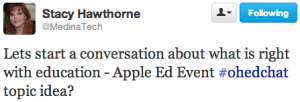I don’t particularly like to show movies in class. I never feel that I have the time. I do realize, however, that movies have an important place in instruction; after all, movies are now a part of the Common Core. In my AP Literature and Composition classes and in my Blended Learning Rhetoric and Composition class I alternate clips from Branagh’s and Zeffirelli’s versions of Hamlet to illustrate how literary critique affects the interpretation of Shakespeare’s themes. Students can compare both directors’ versions of Ophelia, Hamlet’s madness, and of course the final fight scene. The problem I have had with this lesson is that unless the students and I talk over the actors, or unless I constantly stop and restart the scene, there is little opportunity for me to guide a discussion of what we are watching. This year, through experimentation with my Blended Learning Rhetoric and Composition class, I discovered Today’s Meet.
Todaysmeet.com is a back channel discussion board (a bit like Twitter) that allows students to post from their mobile devices or computers. The advantages of using Todaysmeet.com are the following:
1. Students can post their thoughts in real time. They don’t have to wait for me to stop the movie.
2. I can archive all the posts and use them in a follow-up discussion (or the students can use the archived notes in a paper).
3. Students post in a safe environment, which I consider the most important point. I can create a different back channel for each class if I think students will feel more secure sharing their ideas with just their classmates, or I can combine classes if I feel that students will benefit from reviewing their peers’ messages.
Each day of my Dueling Hamlets lesson I start by reminding students to log into the back channel. I provide the url on the board, and I also Chirp the link to any students who use an Apple device. (See the Apple App Store for this cute, free method of sending links, pictures, and notes to a large group of people all at once.) When the movie starts, I can monitor the discussion from my iPad, and I can guide it by sending leading questions: Does Hamlet love Ophelia? Does Ophelia love Hamlet? Notice the frame of this version; what is most important about this movie? Sometimes I allow the students to take on characters’ identifications when they post, and I get little gems such as these:
Yorick: Hey, put down my skull. Everybody, he really didn’t kiss me that much.

Ophelia: You want ME to go to a NUNNERY? How about you go BACK TO COLLEGE?!
Sometimes I find more treasure than I ever thought I could:
Student A: Why is Hamlet clowning around like that? Laertes is the better fighter. It seems like a stupid thing to do.
Student B: I was reading about ancient Samurai warriors and how they used to purposely mock and humiliate their opponents in order to make them lose focus. Do you think Zeffirelli wants Hamlet to do that?
Are you kidding me?!?! Student B was a quiet kid in my class who seldom felt comfortable sharing any of his opinions with his peers. With one comment on the back channel, he managed to blow away the whole class, and he never would have shared his opinion if I would have made him wait for the end of the scene. The affirmations he received after his post really showed me that students were better able to appreciate this sort of interaction because they perceive it as risk-free. Even better were the arguments that students had about each interpretation. Because they were able to debate in real-time, they didn’t have to remember specific lines from the scene to share later. Their opinions were passionate but respectful, and my favorite part was when they challenged each other to support those opinions.
My discovery of Todaysmeet.com really solved a problem that I have had for years. I can now show a clip or a movie and know that the students are engaged. My next step will be to open a back channel during student speeches and my own lectures.
Stephani Itibrout
Rhetoric and Composition
Follow me on Twitter @itibrout





 Earlier this week, I tweeted that we should focus more on what is good in education instead of what is wrong with education. Little did I know when I sent that tweet that I would be challenged to write a blog post on my thoughts. But it is this exact challenge that is central to what is good in education. We all know teachers who come to school every day to challenge and inspire students. They put aside the politics, the testing, the outside pressures, and choose to challenge and inspire students to become lifelong learners. If you know a teacher like this, and I suspect that you do, today would be a great day to let them know that they are central to what is right in education today.
Earlier this week, I tweeted that we should focus more on what is good in education instead of what is wrong with education. Little did I know when I sent that tweet that I would be challenged to write a blog post on my thoughts. But it is this exact challenge that is central to what is good in education. We all know teachers who come to school every day to challenge and inspire students. They put aside the politics, the testing, the outside pressures, and choose to challenge and inspire students to become lifelong learners. If you know a teacher like this, and I suspect that you do, today would be a great day to let them know that they are central to what is right in education today.